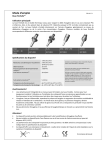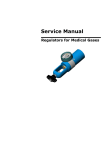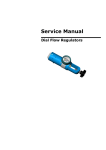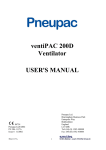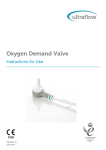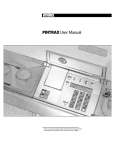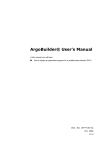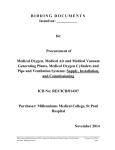Download Operators Manual
Transcript
2. Warnings and Cautions Micro Dial-Flowmeter Instructions for Use 2.1 Warnings! 2.1.1 Read through this entire instruction manual before using or showing others how to use a Micro Dial-Flowmeter. As with all medical equipment, attempting to use this device without a thorough understanding of its operation may result in patient or user injury. 2.1.2 Medical oxygen is or should be considered a drug and should only be used for medical purposes as prescribed by a physician or authorised clinician and in accordance with the medicinal product labelling. 2.1.3 If using a cylinder and regulator, ensure that the device is connected to the regulator and the cylinder valve is properly opened before beginning therapy. 2.1.4 Ensure that the medical oxygen supply is sufficient for the proposed therapy and is supplied within the pressure range given in the Device Specification. If the supply is a gas cylinder, check the cylinder contents gauge regularly. 2.1.5 The Micro Dial-Flowmeter will deliver zero flow between flow settings. When selecting a new flow setting, ensure that the flow selection dial clicks into place and that a flow is correctly selected. 2.1.6 Do not cover the vent hole in the pre-regulator as this will change the device calibration. 2.1.7 Do not submerge a Micro Dial-Flowmeter in any fluid. Ensure that no water is allowed to enter ports or vent holes. 2.1.8 The accuracy of the flowmeter will be affected if the input pressure is other than stated in the specifications. 2.1.9 Always disconnect the flowmeter from the gas supply when it is not in use. 2.1.10 Oxygen is not flammable, however an oxygen enriched atmosphere will drastically increase the rate and severity of combustion. Oil and/or grease in the presence of an oxygen enriched atmosphere will become highly combustible. Oxygen must never be allowed to contact oil, grease or other hydrocarbon based substances. Do not use oil or grease on this Micro DialFlowmeter. 2.1.11 Never administer oxygen while smoking or when near an open flame. 2.1.12 A gas specific connector is fitted to the Micro Dial-Flowmeter. Do not attempt to modify the fittings to suit other gases or fitting systems. 2.1.13 Only appropriately trained personnel working in controlled conditions may disassemble or assemble this Micro Dial-Flowmeter. 702-0072.01 – September 2009 – English 2.2 Cautions! 2.2.1 The performance of the flowmeter may be affected if it is stored or transported in temperature outside of the range -20°C to +60°C (-4°F to +140°F). 3. Functional Description 3.1 Intended Use 1. Symbols Warning! Indicates a potentially hazardous situation which, if not avoided, could result in personal injury to the user or others. Caution! Indicates a potentially hazardous situation which, if not avoided, could result in damage to the equipment or property. The Carnét Micro Dial-Flowmeter is intended to control the flow of medical oxygen during oxygen therapy in both homecare and clinical environments. The flow selection dial has 12 positions, including 11 discrete flow rates and an off position. Flow is indicated in litres per minute (l/min) and is visible through a window adjacent to the flow selection dial. Medical oxygen is or should be considered a drug and should only be used for medical purposes on the authority of a physician and then strictly in accordance with their instructions. Always refer to the medical oxygen product labelling. 3.2 Technical Description Attention, consult accompanying documents. Use No Oil. SERVICE DUE Service due date. RANGE The range of flow rates. See Device Specification for details. The Micro Dial-Flowmeter has a flow selection dial that is rotated to select the desired oxygen flow. Rotating the dial changes the size of the orifice through which the gas passes and consequently adjusts the gas flow rate. The Micro Dial-Flowmeter includes a pre-regulator (pressure regulator) upstream of the metering orifice plate. The pre-regulator provides a consistent pressure upstream of the metering orifice plate over a wide range of inlet pressures. The Micro Dial-Flowmeter has inlet and outlet connectors. The inlet connector is the larger of the two and is a gas specific oxygen probe for connection to the oxygen supply. The smaller outlet connector may be either a barbed outlet for direct connection to oxygen delivery tubing or a threaded DISS (9/16” UNF) connector for connection to a bubble humidifier. Flow Selection Dial Medical Device: CE Marked to the Medical Device Directive 93/42/EEC. Flow Indication Window Outlet Connector Gas Specific Probe Pre-Regulator 4. Operating Instructions 6. Troubleshooting 4.1 Preparation and Connection Turn the flow selection dial fully clockwise and check that the indication in the flowmeter window is zero. Fault Possible Cause Connect the medical oxygen probe securely to the oxygen wall outlet or the equivalent outlet of a pressure regulator connected to an oxygen cylinder. Warning! Where the gas specific connector is dependent on a threaded fastener (e.g. DISS CGA – V5 and AS 2896), make sure that the connection is properly tightened. No gas flow The medical gas terminal unit on a pipeline system is isolated For quick connector probes (e.g. BS5682, DIN, AFNOR), ensure that the connection is correctly made by gently pulling the flowmeter before turning on the supply pressure. If the medical oxygen supply is provided from a gas cylinder, turn on the oxygen supply at the cylinder. Internal/external leak Connect a sufficient length of oxygen tubing (not supplied) to the outlet barb. 4.2 Testing Prior to Use Insufficient gas flow Turn the flow seclection dial to its highest setting and check that gas flow can be felt at the patient end of the supply tubing. If no medical oxygen flow is sensed refer to the troubleshooting guide in section 6 of this manual. Turn off the oxygen flow by turning the flow selection dial fully clockwise. 4.3 Operation Connect the free end of the oxygen tubing to the patient or patient enclosure using the appropriate connector (not supplied). Determine the approximate oxygen flow rate in l/min required for the patient. Turn the flow selection dial until the closest rate to this is clearly visible in the flowmeter window. Ensure the flow selection dial is in the latched position and the flow rate is visible in the window. It will be obvious to the touch when the selection dial clicks into place. Warning! The Micro Dial-Flowmeter will deliver zero flow between flow settings. Solution The gas cylinder is turned off The flowmeter is not connected properly The gas cylinder is empty A filter is blocked Selection dial set to ‘0’ Seal failure A filter is partially occluded The supply pressure is too low and/or gas cylinder is nearly empty Check the gas supply Check that the gas specific probe is correctly connected Replace the gas cylinder Seek advice from someone authorised to operate the medical gas pipeline system isolation valves A service or repair is required Select a positive flow rate A service or repair is required A service is required Check the gas supply and/or replace the gas cylinder 7. Parts and Spares List Inlet Connector/Part Number DISS AS 2896 (CGA V-5) Description BS 5682 Micro Dial-Flowmeter - Range A - Hose Barb Outlet 816-0001 816-0026 816-0032 Micro Dial-Flowmeter - Range A - DISS Outlet 816-0006 - 816-0033 Micro Dial-Flowmeter - Range E - Hose Barb Outlet 816-0003 816-0027 816-0034 Micro Dial-Flowmeter - Range E - DISS Outlet 816-0011 - 816-0035 If the patient requires more or less oxygen flow, this is simply achieved in distinct stages by rotating the flow selection dial. Check the gas cylinder contents regularly (if applicable) during use of the Micro DialFlowmeter and be aware that the supply tubing may be a trip hazard. 4.4 After Use When therapy is complete, disconnect the Micro Dial-Flowmeter from the gas supply. Where the medical oxygen is being supplied from a cylinder, turn the cylinder off. Spare Parts and Servicing 604-0035 Micro Dial-Flowmeter DISS Assembly 610-0040 Micro Dial-Flowmeter Service Kit (5 pack) 999-0003 Dial-Flowmeter Service 604-0034 Micro Dial-Flowmeter Output Barb Assembly Store the Micro Dial-Flowmeter in a clean and dry environment between uses. 5. Maintenance 5.1 Interim Inspection Micro Dial-Flowmeters should be cleaned, inspected for damage and performance checked regularly. The frequency of such checks depends on usage, but as a guideline if the flowmeter is used daily this should be preformed every six months, if used infrequently then an annual check will suffice. 5.1.1 5.1.2 5.1.3 5.1.4 Cleaning Wipe over the external surfaces of the Micro Dial-Flowmeter with an alcohol or disinfecting wipe. Internal Leak Test Attach the flowmeter to the medical oxygen supply and turn the flow selection dial to ‘0’. Connect a length of tubing to the outlet barb and immerse the other end of the tube in water. Any gas bubbling through indicates an internal leak. If any leakage is found the flowmeter should be removed from use and serviced as described in section 5.2. External Leak Test Attach the flowmeter to the medical oxygen supply and turn the flow selection dial to its highest flow rate (1 or 3 l/min depending on model). Apply an oxygen compatible leak test solution to all joints and check for signs of leakage. If any leakage is found the flowmeter should be removed from use and serviced as described in section 5.2. Flow Test Verify flow rates at all flow settings against specification i.e. within ±10% at 1 l/min and above or ± 20% below 1 l/min. 8. Device Specification Specification Value Nominal Inlet Pressure 345 kPa to 500 kPa (50 psi to 73 psi) Supply Pressure Maximum 1000 kPa (145 psi) Minimum 280 kPa (40 psi) Flow Settings (l/min) Range A: 0, 0.02, 0.03, 0.05, 0.08, 0.12, 0.2, 0.3, 0.5, 0.75, 1, 3 Range E: 0, 0.01, 0.02, 0.03, 0.04, 0.05, 0.06, 0.07, 0.08, 0.09, 0.1, 1 Filtration Sintered bronze: 40 µm nominal first stage, 5 µm nominal second stage Accuracy ±10% of reading at 1 l/min and above, ±20% of reading below 1 l/min Varying Inlet Pressure: Effects on Accuracy Less than 3% of reading for ± 100 kPa change in nominal input pressure. Less than 12% change in reading in the range (280 kPa to 1000 kPa). Varying Temperature: ±7% in the range 20°C ±20°C Varying Outlet Resistance: Less than 1% of reading up to 5 kPa resistance Environmental Transport/Storage/Operation: -20°C to +60°C (-4°F to +140°F) Humidity: 0-100% RH non-condensing Regulatory CE: Medical Device Directive 93/42/EEC – Class lla FDA: Class 1 5.2 Service The Micro Dial-Flowmeter must be serviced every 2 years to ensure that it continues to perform in accordance with its specification. Micro Dial-Flowmeters have a Service Due date on their labelling, which indicates when the next service is due. Warning! Servicing must be carried out by a suitably qualified person working in a controlled environment. Full details of the recommended servicing requirements can be found in the Service Manual. The Service Manual can be obtained from your local Carnét distributor, details of which can be found at www.carnetmedical.com. Complete the service in accordance with the instructions given in the Service Manual or return the device to a recognised Carnét Service Centre on or before the date shown. EN ISO 15002 – Flow-metering devices for connection to terminal units of medical gas pipeline systems Applied Standards EN 738-1 – Pressure regulators for use with medical gases - Part 1: Pressure regulators and pressure regulators with metering devices. EN ISO 15001 - Anaesthetic and respiratory equipment - Compatibility with Oxygen


